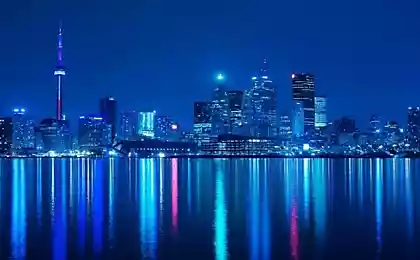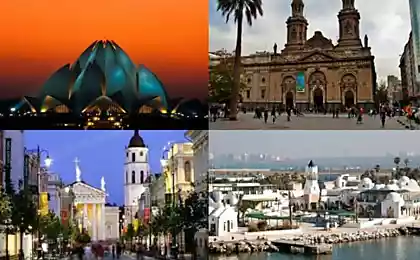817
"Smart cities improve the environment inside, saving the planet's climate
More than half of the population lives in cities, consuming 75% of global energy. Today they are the key conduits of global transformation of the system of production and consumption of electricity and heat. Low-carbon and energy efficient strategy at the city level often show themselves more potent and ambitious than national, and are for the most recent example.
Responsible of all countries, unite
In this century reinterpreted the concept of the urban environment as a model for sustainable existence of humanity came to the fore. Cities now owned a significant role in shaping the environment, not only for its residents but for the whole country and even global scale, and in many cities understand this responsibility well.
"At the city level management of possible real actions," said Gino van begin (Gino Van Begin, Secretary General of the international network of Local governments for sustainable development (Local Governments for Sustainability, ICLEI), while held in June in Bonn negotiating session of the United Nations on climate change, where great attention was paid to clean energy in the urban environment. ICLEI brings together more than thousands of cities and towns in 84 countries, helping the participants to move to a sustainable, low-carbon, ecomobile, healthy, green and smart future.

Another Association of municipalities for the development of local sustainable energy and improve the quality of life is an initiative of the EU "Covenant of mayors" (Covenant of Mayors, Catfish). More than 6,000 European cities joined it, committing themselves to increase energy efficiency of settlements by 20% (which will make up a total of 479 TWh) by 2020 and the production of 18% of the local energy (which will be 133 terawatt-hours) from renewable sources.
According to technical experts, the greatest potential for energy savings in the cities have buildings, district heating, transport and lighting. The more active the efforts will guide the city for the use of this potential, the greater the harm reduction from the urban environment will be achieved for the environment and climate.
"Cities are the key partners in the implementation of "Sustainable energy for all" in life. With their help, we can change our ways of production and consumption of energy and thus significantly reduce the impacts of climate change, to accelerate economic development, reduce environmental pollution", – said the candidate Yumkella (Kandeh Yumkella, special representative of the UN Secretary-General and Executive Director of the initiative "Sustainable energy for all (Sustainable Energy for All).
Healthy home – healthy population
According to the International energy Agency (IEA) in 2013, the energy consumption of buildings – heating and cooling of indoor air, water heating, lighting, cooking, etc. – is about 40% of total energy consumption in the world. During the next 20 years, about 60% of all buildings in the world will be built or rebuilt it in urban areas, mainly in developing countries.
The energy efficiency of buildings, according to the intergovernmental panel on climate change (IPCC) of the United Nations, directly linked to the health status of the population: in 2010, the atmospheric pollution in the open air was the reason for 3.7 million deaths, and the contamination of indoor air 4.3 million deaths.
The movement towards "improvement" of homes in which living, working or studying urban population, is gaining momentum in the world, and especially the development of visual examples of many commercial companies and professional associations seeking to bring their vision and their skills to politicians and authorities.
"We know that healthy and comfortable indoor climate increases the performance, improves health and reduces morbidity, improves student performance. These values must be taken into account when we talk about resource efficiency in the construction sector. We have now the opportunity, and this should be reflected [...] in future editions of the EU Directive on the energy performance of buildings", – said Kurt Emil Eriksen (Kurt Emil Eriksen, General Secretary of the organization ActiveHouse (non-profit Association uniting companies and building industry professionals, architects, engineers) and a senior policy adviser of the company VELUX.
Large Danish company VELUX specializiruetsya on the technology of manufacturing of Windows and glass roofs and, according to the website, the company aims to play an active role in shaping public policy in the field of sustainable livelihoods and energy efficiency in buildings.
Due to the existing energy-efficient materials and technologies in new or upgraded buildings can consume up to 60-90% less energy than conventional buildings of the same type and, according to, for example, a study from 2009, the world business Council for sustainable development (World Business Council for Sustainable Development), these investments economically viable in all countries and climatic zones.
And the city hears industry representatives. For example, according to the network "Local authorities for sustainable development, good insulation can reduce heating costs by 90% at a cost of $ 100 per square meter.
The authorities of Barcelona argue that even low-cost measures to improve energy efficiency of school and municipal buildings can reduce energy consumption by 30%. The same result counting the 14 municipalities of Presov region in Slovakia, announced in June the launch of a program aimed at reducing energy consumption in public buildings (including thermal insulation, heating, lighting, the installation of solar panels and collectors), as well as the reduction of energy consumption in street lighting. The program is funded by the European investment Bank through the mechanism of "Support for local energy in Europe" (European Local ENergy Assistance ELENA).
Central heating is a step forward
The transition to a more modern system of district heating plants, as shown by the recent report of the UN environment programme, or UNEP (United Nations Environment Program, UNEP), can halve the consumption of primary energy for heating and cooling buildings in the world by 2050.
For cogeneration of heat and electricity in the cities can be used for geothermal sources, the sun, passing the heat from industrial processes, waste water, domestic waste biomass. Cogeneration systems, which store energy generated by wind turbines are common, for example, in the Danish cities.
A city is a good example of how district heating can provide residents with affordable energy from local sources, saving the city money. At the same energy trying to get carbon-free or low-carbon, in other words – the city authorities and entrepreneurs seek and find ways for heating and air conditioning completely or to significantly reduce total emissions of greenhouse gases, especially carbon dioxide, into the atmosphere. So, in the capital of Minnesota Saint Paul system of district heating plants running on municipal wood waste annually, saving the city 275 tons of coal and 12 million dollars. In Paris there is the first and largest system in Europe is district C, which is used for cooling water from the Seine. And in Toronto, Canada using the lake water to the district cooling system reduces the consumption of electricity for air conditioning by 90%. Moreover, the city government privatized 43% of the shares system, district heating systems, brought to the municipality of $ 89 million, which were used in other projects for the development of sustainable urban infrastructure.
Another approach is improving the efficiency of utilization of energy sources, including traditional, which also gives the effect of the economy and reduce overall emissions. Station of district heating in Helsinki working with a very high efficiency, converting up to 93% of the primary energy into electricity and heat. Even in Britain, where until today the house was heated mainly by in-house gas boiler installations, Central heating system is going through a Renaissance now providing 2% of the needs of the residential sector in energy by 2030, it must cover is 20%, according to the website of the International Association of centralised energy (International District Energy Association) the representative of the consulting engineering company Ramboll Crispin Matson (Crispin Matson). The filing, with an effective reduction of heat loss, thermal energy from combined heat and power stations where produced simultaneously with electricity heat is used and not wasted is dumped into the atmosphere or water cooling, says Mattsson, provides the potential for reducing the financial costs and carbon emissions.
Such stations can run on gas, biomass or incinerated waste, which from the point of view of emissions, less optimal than the use of renewable sources of energy, but still gives the opportunity to make a step towards carbon-free energy supply.
And already almost reached this goal, Amsterdam: according to the plan adopted six years ago, all municipal economy of the Dutch capital in 2015 should be a completely carbon-free. While "green" has become not only the buildings and transport, and street lighting.
Enlightenment about lighting
For lighting, according to UNEP from 2012, spent 15% of all electricity in the world, and this figure is from 2010, and in 2005 it was 19%. In order to accelerate a global transition to a sustainable, energy-efficient lighting technologies and phasing out of outgoing into the past of incandescent lamps in 2009, the initiative was created UNEP en.lighten.
The project is aimed at interregional cooperation in the field of efficient lighting, including the exchange of information and best practices, harmonization of standards, regulations and administrative processes and incentives, as well as reducing cost, improving quality control and consumer confidence in energy efficient products.
Of all the measures that can be directed to the decarbonization of cities, said the initiative, a few of the low cost and simplicity compared with the rejection of inefficient street lighting. The transition to efficient lighting worldwide could save 140 billion dollars annually and reduce carbon dioxide emissions by 580 million tonnes.
While energy-efficient technologies in lighting, too, is not standing still. In addition to reducing costs and emissions from the combustion of fossil fuels the development of modern technologies allows to gradually improve the eco-friendliness of the lamps themselves – for example, the world is gradually abandoning acquired popularity of mercury-containing energy-saving lamps, which, after the expiration of the service require processing to avoid dangerous mercury compounds in the environment. Mercury lamps can be replaced led.
From mercury, and then sodium lamps on its streets refused German Dormagen (Dormagen), in the administrative district of Dusseldorf. The transition to highly efficient lamps of public lighting in Dormagen allowed more than halve the consumption of electricity. Amount of saved electricity is 485,5 thousand kilowatt-hours and monthly savings in electricity and 7.4 million euros. Upon completion of the project, started in 2006, in the spring of 2016 is expected to reduce electricity consumption in lighting by 65%.
Night, street, ...led lamp, drugstore
"These successful projects are not uncommon in the field of street lighting, says dormienti the project on the website of the network "Climate Alliance (Climate Alliance), bringing together 1,700 municipalities throughout Europe, senior expert network on green public procurement Andreas Kress Andreas Kress). – The example of the transition to led lighting proves that it is economically justified, easily and reproducibly provides local authorities with considerable savings of energy."
A similar project to replace street lamps in the mining town of Rovinari (Rovinari) in Romania has reduced energy consumption by 35%. And the German and Romanian projects have been implemented in the framework of the European Green ProcA, aimed at developing "green" public procurement mainly cities – signatories of "Covenant of mayors".
While in the Azerbaijani capital Baku within the framework of the demonstration project in the Old town of Icheri Sheher set of 600 led lights. After replacing all 2000 of fluorescent, halogen and sodium high-pressure lamps to led outdoor lighting in the municipality, working 13 hours a day, will consume only 170 thousand kilowatt-hours of electricity instead of the current 474 thousand kilowatt-hours.
The project is part of the municipality of Icheri Sheher action Plan for sustainable energy development of the city and koordiniruyutsya UNEP initiative en.lighten and also programme of the European Commission "Covenant of mayors – East", Baku joined in 2012. In the project the Covenant of mayors for Sustainable energy planning for cities: Eastern Europe and South Caucasus" was also attended Vinnitsa Ukrainian and Moldovan Balti. And in addition to the common goal of reducing energy consumption by 20% by 2020 Icheri Sheher also plans to become a city without cars.
Town: catch up and overtake the government
Measures for the decarbonization of the city's concern, of course, and urban transport – including improving its energy efficiency, the introduction of mandatory fuel economy standards, translation into alternative energy sources, modernization of road transport infrastructure, the development of Cycling.
When thinking about friendly to the environment and man city transport system first comes to mind is Copenhagen. Just over half – 52% – of the inhabitants of the Danish capital call a Bicycle as his principal means of transportation, and the ratio of ownership of the bike and car among citizens is five to one. The Copenhagen metro in 2008 was recognized as the best in the world – but if public transportation is convenient, the more citizens use them than a personal car. But the city wants to make its transportation system smarter and "greener" and enter, for example Stockholm, charging for entry into an area with congested traffic that will have a positive impact on traffic and air quality.
Here is the Copenhagen plan of ecomobility by 2025: 75% of movements are made by foot, bike or public transport; 50% of residents commute to work and school by bike; the number of public transport passengers increased by 20% from 2009 levels; public transport goes to carbon-free energy sources; 20-30% of cars and 30-40% of heavy vehicles use of renewable sources.
In General, Copenhagen, won the title "European Green capital" last year, intends to become the world's first carbon free capital by 2025, thus beating the national goal for 25 years: Denmark in General, intends to completely abandon fossil fuels by 2050. Now the source of power for the city's thermal power plants which are connected to 98% of the population is household waste and biomass. But 4% consumed by the city of electricity produces located in port wind farm, owned by the municipality and 9000 small-scale private investors, and by 2020, the authorities of Copenhagen are going to provide half the needs of the city's electricity through wind energy.
Setting a goal "to become green, smart and carbon-free city by 2025, Copenhagen wants to be a role model for European cities, it is told in the official brochure is the winner 2014 on the website of "European Green capital". In ten years the city intends to reduce the heat consumption by 20%, electricity consumption in the commercial sector by 20% in the residential sector – 10% in comparison with 2010, as well as to produce 1% electricity by using solar panels.
In energy production, the capital of Denmark plans to achieve the decarbonization of the system of district heating, electricity generation by wind and biomass exceeds the needs, the introduction of the production of biomethane is biogas, produced by decomposing organic material – organic wastes.
Individual commitments were made by the city government: administrative buildings should reduce energy consumption by 40% from 2010 levels, and new buildings to meet new energy efficiency standards. In addition, the city-owned vehicles switching to alternative fuels, electricity consumption for street lighting is reduced by 50%, and municipal buildings will be installed 60 thousand square meters of solar panels.
Megacities vs global warming
According to Mark watts (Mark Watts, Executive Director of the Group of cities – the climate leaders" (C40) is a network of the world's megacities committed to combat climate change, the Copenhagen approach to urban wind power is carefully considered by other major cities. "In Copenhagen was very clever, making significant investments in wind in the last decade," said watts in comments to the newspaper "Gardian". – As elsewhere in the world, there was a rejection for aesthetic reasons, but they were able to overcome it by making the local residents in whose sight are the turbine, the shareholders of the company."
Växjö (Växjö, a small town in the South of Sweden, the world's first announced a policy of urban decarbonization, in 1996 with the objective to achieve carbon-neutral status by 2030. The system of district heating and energy supply, similar to Copenhagen, is almost completely provided by waste local timber industry. A quarter of the electricity in the city is produced by local renewable sources, and with the electricity coming from the Swedish power grid, the proportion of clean energy in växjö is 65%.
Created by the Scandinavian model of the district heating system, which belongs to the municipality and operates a biomass, organic waste and gas, helped the British city of Bristol to win the title "European Green capital" this year. In addition, in Bristol 15% consumed by the city's electricity is produced by renewable sources: the city owns two wind power plants and installs photovoltaic panels on school buildings.
There is a reason why city are ahead of their state in taking on climate commitments and achieving ambitious targets: clean energy technologies are often easier to apply at the local level than at the national. According to Boll Alix (Alix Bolle from the European Association "Energy cities" (Energy Cities), the city can make decisions at the right level and with the correct speed and is capable of faster than national governments, to make the next step to energy transformation".
Cities without fossil fuels
In March Oslo was the first capital, who joined the "No fossil" Fossil Free), announcing the withdrawal of $ 7 million pension Fund investment in the coal industry. The campaign, launched by the international organization of civil action to prevent climate change "350.org" in 2011, engulfed the city and organizations in the United States, Australia and New Zealand, and last year came to Europe and became, according to a study conducted Shmitovskii school of enterprise and environment at Oxford University, the fastest growing movement for the withdrawal of capital in history. More than 40 cities, from Seattle to the American Swedish örebro (Örebro), which last year reduced investment in fossil energy resources from 2 million to 655 million euros already pledged to stop investing money in "dirty" energy.
Shortly afterwards, the guardian published a statement by the mayors of 26 major European cities in which they are referring to the total investment capacity of cities to 2 trillion euros, announced the decision "to join forces and tools that will lead us to energy and environmental transformation".
However, activists of the campaign "Without resources," see "the contradictions between these words and other actions" cities – that is, continued investment in infrastructure projects that encourage the use of fossil energy sources. The city authorities it is not easy to oppose oil and coal lobby: according to "Oxfam" (Oxfam), international Association of organizations that combat poverty, in 2013, the hydrocarbon industry has spent $ 213 million – more than half a million a day on lobbying US politicians and the EU. But resistance is possible, when it is about environmental organizations and active members of society.
So recently occurred in Portland, where last September with construction of a terminal for transshipment of Bhutan came Pembina Pipeline, a major canadian carrier hydrocarbons. However, less than a year, as under the pressure of mass protests of local residents the mayor was forced to abandon the proposal. "The winner in the struggle for political influence was not a multibillion-dollar energy company, armed with promises of new jobs and millions in tax revenues. But environmentalists," wrote about this canadian The Globe and Mail.
"I think the main engine in this matter were the values of the local community: we don't want to be a part of this industry," said Bob Salinger (Bob Sallinger) from the Portland branch of the American environmental NGO "National Dubovskoe society (The National Audubon Society).
The dark side of the city
So with coal in the United States to some extent over new coal plants not equipped with technology to capture and store CO2, preventing its emission to the atmosphere in American cities will not appear again, the obsolete closed, and by 2030 the share of coal in electricity production in the country will decrease from the current 40% to 13%. Meanwhile, in China, India, Japan retains reverse the trend. Japan wants to build 43 coal plant to compensate for the loss of power generating facilities of Fukushima nuclear power plant, and to invest in coal projects in India and Bangladesh. But they have to obey the global transformation: at the June summit of the countries "the Big seven" promised to take the policy of decarbonizing economies by the year 2100, and China, where the share of coal accounts for nearly 70% of the energy mix, with plans to reduce this figure to 50%.
However, now China consumes half of the coal in the world, and in the city of Heyuan people come to the demonstration with the slogans "Return the blue sky" and "Enough to feed the people smog" and are collecting signatures against the construction of a new coal plant, which could begin this year. In June declared a hunger strike in protest against construction of coal plant in Krabi Taiwanese activists; there was opened the exhibition "the Dark side of the city" dedicated to the victims of the coal plant in Lampang province.
Even homeland Energiewende, or "energy transition," the country that have pledged to turn off last nuclear reactor by 2022, to 60% of energy from renewable sources by 2050, and to completely abandon fossil fuels by the end of the century, the energy transition is not easy. An example of the complex relationship of Germany with traditional energy can serve as an energy term construction near Hamburg, where since 2004 Vattenfall has tried to build a coal station Moorburg.
In 2007, when the construction contract has been concluded, the mass protests of the inhabitants, in which the main body of Executive authority, the Senate of Hamburg refused the construction of the power plant. This, in turn, sparked protests by hundreds of employees of the company under the slogan "Moorburg creates jobs."
After a series of trials, in 2014, the station was built and commissioned, and is now the second largest coal plant Germany, adorns the shore of the Elbe as "a monument to the incompatibility of coal-fired power plants and municipal climate strategies," writes energy consultant Jeffrey Michael (Jeffrey H. Michel), noting: Hamburg pledged to reduce CO2 emissions to 4 million tonnes by 2050, but with the current station, whose emissions can be up to 8.7 million tonnes annually, this will not work.
The coal problem is twofold: damage to cities wishing to heat their homes and light their streets with coal plants, coal, possibly further damaging the regions where its production, as evidenced by the discouraging examples in North Rhine – Westphalia, in Germany, the region of Xinjiang in China, or Kuzbass in Russia – disfigured land, polluted air and water are suffering from pollution-related diseases by local residents.
However, according to a new study by the American environmental organization Sierra Club, one of the coal construction project in the world there are two rejected, while in Europe this ratio reaches seven failed projects one realized. And this trend is encouraging. After all, if now the city ahead of the rest and their national governments, do one step after another to improve their environment and climate in General, in the future for "dirty" energy should no longer remain place. published
Author: Galina Raguzina
P. S. And remember, only by changing their consumption — together we change the world! ©
Join us in Facebook , Vkontakte, Odnoklassniki
Source: www.bellona.ru/articles_ru/articles_2015/smart_cities
Responsible of all countries, unite
In this century reinterpreted the concept of the urban environment as a model for sustainable existence of humanity came to the fore. Cities now owned a significant role in shaping the environment, not only for its residents but for the whole country and even global scale, and in many cities understand this responsibility well.
"At the city level management of possible real actions," said Gino van begin (Gino Van Begin, Secretary General of the international network of Local governments for sustainable development (Local Governments for Sustainability, ICLEI), while held in June in Bonn negotiating session of the United Nations on climate change, where great attention was paid to clean energy in the urban environment. ICLEI brings together more than thousands of cities and towns in 84 countries, helping the participants to move to a sustainable, low-carbon, ecomobile, healthy, green and smart future.

Another Association of municipalities for the development of local sustainable energy and improve the quality of life is an initiative of the EU "Covenant of mayors" (Covenant of Mayors, Catfish). More than 6,000 European cities joined it, committing themselves to increase energy efficiency of settlements by 20% (which will make up a total of 479 TWh) by 2020 and the production of 18% of the local energy (which will be 133 terawatt-hours) from renewable sources.
According to technical experts, the greatest potential for energy savings in the cities have buildings, district heating, transport and lighting. The more active the efforts will guide the city for the use of this potential, the greater the harm reduction from the urban environment will be achieved for the environment and climate.
"Cities are the key partners in the implementation of "Sustainable energy for all" in life. With their help, we can change our ways of production and consumption of energy and thus significantly reduce the impacts of climate change, to accelerate economic development, reduce environmental pollution", – said the candidate Yumkella (Kandeh Yumkella, special representative of the UN Secretary-General and Executive Director of the initiative "Sustainable energy for all (Sustainable Energy for All).
Healthy home – healthy population
According to the International energy Agency (IEA) in 2013, the energy consumption of buildings – heating and cooling of indoor air, water heating, lighting, cooking, etc. – is about 40% of total energy consumption in the world. During the next 20 years, about 60% of all buildings in the world will be built or rebuilt it in urban areas, mainly in developing countries.
The energy efficiency of buildings, according to the intergovernmental panel on climate change (IPCC) of the United Nations, directly linked to the health status of the population: in 2010, the atmospheric pollution in the open air was the reason for 3.7 million deaths, and the contamination of indoor air 4.3 million deaths.
The movement towards "improvement" of homes in which living, working or studying urban population, is gaining momentum in the world, and especially the development of visual examples of many commercial companies and professional associations seeking to bring their vision and their skills to politicians and authorities.
"We know that healthy and comfortable indoor climate increases the performance, improves health and reduces morbidity, improves student performance. These values must be taken into account when we talk about resource efficiency in the construction sector. We have now the opportunity, and this should be reflected [...] in future editions of the EU Directive on the energy performance of buildings", – said Kurt Emil Eriksen (Kurt Emil Eriksen, General Secretary of the organization ActiveHouse (non-profit Association uniting companies and building industry professionals, architects, engineers) and a senior policy adviser of the company VELUX.
Large Danish company VELUX specializiruetsya on the technology of manufacturing of Windows and glass roofs and, according to the website, the company aims to play an active role in shaping public policy in the field of sustainable livelihoods and energy efficiency in buildings.
Due to the existing energy-efficient materials and technologies in new or upgraded buildings can consume up to 60-90% less energy than conventional buildings of the same type and, according to, for example, a study from 2009, the world business Council for sustainable development (World Business Council for Sustainable Development), these investments economically viable in all countries and climatic zones.
And the city hears industry representatives. For example, according to the network "Local authorities for sustainable development, good insulation can reduce heating costs by 90% at a cost of $ 100 per square meter.
The authorities of Barcelona argue that even low-cost measures to improve energy efficiency of school and municipal buildings can reduce energy consumption by 30%. The same result counting the 14 municipalities of Presov region in Slovakia, announced in June the launch of a program aimed at reducing energy consumption in public buildings (including thermal insulation, heating, lighting, the installation of solar panels and collectors), as well as the reduction of energy consumption in street lighting. The program is funded by the European investment Bank through the mechanism of "Support for local energy in Europe" (European Local ENergy Assistance ELENA).
Central heating is a step forward
The transition to a more modern system of district heating plants, as shown by the recent report of the UN environment programme, or UNEP (United Nations Environment Program, UNEP), can halve the consumption of primary energy for heating and cooling buildings in the world by 2050.
For cogeneration of heat and electricity in the cities can be used for geothermal sources, the sun, passing the heat from industrial processes, waste water, domestic waste biomass. Cogeneration systems, which store energy generated by wind turbines are common, for example, in the Danish cities.
A city is a good example of how district heating can provide residents with affordable energy from local sources, saving the city money. At the same energy trying to get carbon-free or low-carbon, in other words – the city authorities and entrepreneurs seek and find ways for heating and air conditioning completely or to significantly reduce total emissions of greenhouse gases, especially carbon dioxide, into the atmosphere. So, in the capital of Minnesota Saint Paul system of district heating plants running on municipal wood waste annually, saving the city 275 tons of coal and 12 million dollars. In Paris there is the first and largest system in Europe is district C, which is used for cooling water from the Seine. And in Toronto, Canada using the lake water to the district cooling system reduces the consumption of electricity for air conditioning by 90%. Moreover, the city government privatized 43% of the shares system, district heating systems, brought to the municipality of $ 89 million, which were used in other projects for the development of sustainable urban infrastructure.
Another approach is improving the efficiency of utilization of energy sources, including traditional, which also gives the effect of the economy and reduce overall emissions. Station of district heating in Helsinki working with a very high efficiency, converting up to 93% of the primary energy into electricity and heat. Even in Britain, where until today the house was heated mainly by in-house gas boiler installations, Central heating system is going through a Renaissance now providing 2% of the needs of the residential sector in energy by 2030, it must cover is 20%, according to the website of the International Association of centralised energy (International District Energy Association) the representative of the consulting engineering company Ramboll Crispin Matson (Crispin Matson). The filing, with an effective reduction of heat loss, thermal energy from combined heat and power stations where produced simultaneously with electricity heat is used and not wasted is dumped into the atmosphere or water cooling, says Mattsson, provides the potential for reducing the financial costs and carbon emissions.
Such stations can run on gas, biomass or incinerated waste, which from the point of view of emissions, less optimal than the use of renewable sources of energy, but still gives the opportunity to make a step towards carbon-free energy supply.
And already almost reached this goal, Amsterdam: according to the plan adopted six years ago, all municipal economy of the Dutch capital in 2015 should be a completely carbon-free. While "green" has become not only the buildings and transport, and street lighting.
Enlightenment about lighting
For lighting, according to UNEP from 2012, spent 15% of all electricity in the world, and this figure is from 2010, and in 2005 it was 19%. In order to accelerate a global transition to a sustainable, energy-efficient lighting technologies and phasing out of outgoing into the past of incandescent lamps in 2009, the initiative was created UNEP en.lighten.
The project is aimed at interregional cooperation in the field of efficient lighting, including the exchange of information and best practices, harmonization of standards, regulations and administrative processes and incentives, as well as reducing cost, improving quality control and consumer confidence in energy efficient products.
Of all the measures that can be directed to the decarbonization of cities, said the initiative, a few of the low cost and simplicity compared with the rejection of inefficient street lighting. The transition to efficient lighting worldwide could save 140 billion dollars annually and reduce carbon dioxide emissions by 580 million tonnes.
While energy-efficient technologies in lighting, too, is not standing still. In addition to reducing costs and emissions from the combustion of fossil fuels the development of modern technologies allows to gradually improve the eco-friendliness of the lamps themselves – for example, the world is gradually abandoning acquired popularity of mercury-containing energy-saving lamps, which, after the expiration of the service require processing to avoid dangerous mercury compounds in the environment. Mercury lamps can be replaced led.
From mercury, and then sodium lamps on its streets refused German Dormagen (Dormagen), in the administrative district of Dusseldorf. The transition to highly efficient lamps of public lighting in Dormagen allowed more than halve the consumption of electricity. Amount of saved electricity is 485,5 thousand kilowatt-hours and monthly savings in electricity and 7.4 million euros. Upon completion of the project, started in 2006, in the spring of 2016 is expected to reduce electricity consumption in lighting by 65%.
Night, street, ...led lamp, drugstore
"These successful projects are not uncommon in the field of street lighting, says dormienti the project on the website of the network "Climate Alliance (Climate Alliance), bringing together 1,700 municipalities throughout Europe, senior expert network on green public procurement Andreas Kress Andreas Kress). – The example of the transition to led lighting proves that it is economically justified, easily and reproducibly provides local authorities with considerable savings of energy."
A similar project to replace street lamps in the mining town of Rovinari (Rovinari) in Romania has reduced energy consumption by 35%. And the German and Romanian projects have been implemented in the framework of the European Green ProcA, aimed at developing "green" public procurement mainly cities – signatories of "Covenant of mayors".
While in the Azerbaijani capital Baku within the framework of the demonstration project in the Old town of Icheri Sheher set of 600 led lights. After replacing all 2000 of fluorescent, halogen and sodium high-pressure lamps to led outdoor lighting in the municipality, working 13 hours a day, will consume only 170 thousand kilowatt-hours of electricity instead of the current 474 thousand kilowatt-hours.
The project is part of the municipality of Icheri Sheher action Plan for sustainable energy development of the city and koordiniruyutsya UNEP initiative en.lighten and also programme of the European Commission "Covenant of mayors – East", Baku joined in 2012. In the project the Covenant of mayors for Sustainable energy planning for cities: Eastern Europe and South Caucasus" was also attended Vinnitsa Ukrainian and Moldovan Balti. And in addition to the common goal of reducing energy consumption by 20% by 2020 Icheri Sheher also plans to become a city without cars.
Town: catch up and overtake the government
Measures for the decarbonization of the city's concern, of course, and urban transport – including improving its energy efficiency, the introduction of mandatory fuel economy standards, translation into alternative energy sources, modernization of road transport infrastructure, the development of Cycling.
When thinking about friendly to the environment and man city transport system first comes to mind is Copenhagen. Just over half – 52% – of the inhabitants of the Danish capital call a Bicycle as his principal means of transportation, and the ratio of ownership of the bike and car among citizens is five to one. The Copenhagen metro in 2008 was recognized as the best in the world – but if public transportation is convenient, the more citizens use them than a personal car. But the city wants to make its transportation system smarter and "greener" and enter, for example Stockholm, charging for entry into an area with congested traffic that will have a positive impact on traffic and air quality.
Here is the Copenhagen plan of ecomobility by 2025: 75% of movements are made by foot, bike or public transport; 50% of residents commute to work and school by bike; the number of public transport passengers increased by 20% from 2009 levels; public transport goes to carbon-free energy sources; 20-30% of cars and 30-40% of heavy vehicles use of renewable sources.
In General, Copenhagen, won the title "European Green capital" last year, intends to become the world's first carbon free capital by 2025, thus beating the national goal for 25 years: Denmark in General, intends to completely abandon fossil fuels by 2050. Now the source of power for the city's thermal power plants which are connected to 98% of the population is household waste and biomass. But 4% consumed by the city of electricity produces located in port wind farm, owned by the municipality and 9000 small-scale private investors, and by 2020, the authorities of Copenhagen are going to provide half the needs of the city's electricity through wind energy.
Setting a goal "to become green, smart and carbon-free city by 2025, Copenhagen wants to be a role model for European cities, it is told in the official brochure is the winner 2014 on the website of "European Green capital". In ten years the city intends to reduce the heat consumption by 20%, electricity consumption in the commercial sector by 20% in the residential sector – 10% in comparison with 2010, as well as to produce 1% electricity by using solar panels.
In energy production, the capital of Denmark plans to achieve the decarbonization of the system of district heating, electricity generation by wind and biomass exceeds the needs, the introduction of the production of biomethane is biogas, produced by decomposing organic material – organic wastes.
Individual commitments were made by the city government: administrative buildings should reduce energy consumption by 40% from 2010 levels, and new buildings to meet new energy efficiency standards. In addition, the city-owned vehicles switching to alternative fuels, electricity consumption for street lighting is reduced by 50%, and municipal buildings will be installed 60 thousand square meters of solar panels.
Megacities vs global warming
According to Mark watts (Mark Watts, Executive Director of the Group of cities – the climate leaders" (C40) is a network of the world's megacities committed to combat climate change, the Copenhagen approach to urban wind power is carefully considered by other major cities. "In Copenhagen was very clever, making significant investments in wind in the last decade," said watts in comments to the newspaper "Gardian". – As elsewhere in the world, there was a rejection for aesthetic reasons, but they were able to overcome it by making the local residents in whose sight are the turbine, the shareholders of the company."
Växjö (Växjö, a small town in the South of Sweden, the world's first announced a policy of urban decarbonization, in 1996 with the objective to achieve carbon-neutral status by 2030. The system of district heating and energy supply, similar to Copenhagen, is almost completely provided by waste local timber industry. A quarter of the electricity in the city is produced by local renewable sources, and with the electricity coming from the Swedish power grid, the proportion of clean energy in växjö is 65%.
Created by the Scandinavian model of the district heating system, which belongs to the municipality and operates a biomass, organic waste and gas, helped the British city of Bristol to win the title "European Green capital" this year. In addition, in Bristol 15% consumed by the city's electricity is produced by renewable sources: the city owns two wind power plants and installs photovoltaic panels on school buildings.
There is a reason why city are ahead of their state in taking on climate commitments and achieving ambitious targets: clean energy technologies are often easier to apply at the local level than at the national. According to Boll Alix (Alix Bolle from the European Association "Energy cities" (Energy Cities), the city can make decisions at the right level and with the correct speed and is capable of faster than national governments, to make the next step to energy transformation".
Cities without fossil fuels
In March Oslo was the first capital, who joined the "No fossil" Fossil Free), announcing the withdrawal of $ 7 million pension Fund investment in the coal industry. The campaign, launched by the international organization of civil action to prevent climate change "350.org" in 2011, engulfed the city and organizations in the United States, Australia and New Zealand, and last year came to Europe and became, according to a study conducted Shmitovskii school of enterprise and environment at Oxford University, the fastest growing movement for the withdrawal of capital in history. More than 40 cities, from Seattle to the American Swedish örebro (Örebro), which last year reduced investment in fossil energy resources from 2 million to 655 million euros already pledged to stop investing money in "dirty" energy.
Shortly afterwards, the guardian published a statement by the mayors of 26 major European cities in which they are referring to the total investment capacity of cities to 2 trillion euros, announced the decision "to join forces and tools that will lead us to energy and environmental transformation".
However, activists of the campaign "Without resources," see "the contradictions between these words and other actions" cities – that is, continued investment in infrastructure projects that encourage the use of fossil energy sources. The city authorities it is not easy to oppose oil and coal lobby: according to "Oxfam" (Oxfam), international Association of organizations that combat poverty, in 2013, the hydrocarbon industry has spent $ 213 million – more than half a million a day on lobbying US politicians and the EU. But resistance is possible, when it is about environmental organizations and active members of society.
So recently occurred in Portland, where last September with construction of a terminal for transshipment of Bhutan came Pembina Pipeline, a major canadian carrier hydrocarbons. However, less than a year, as under the pressure of mass protests of local residents the mayor was forced to abandon the proposal. "The winner in the struggle for political influence was not a multibillion-dollar energy company, armed with promises of new jobs and millions in tax revenues. But environmentalists," wrote about this canadian The Globe and Mail.
"I think the main engine in this matter were the values of the local community: we don't want to be a part of this industry," said Bob Salinger (Bob Sallinger) from the Portland branch of the American environmental NGO "National Dubovskoe society (The National Audubon Society).
The dark side of the city
So with coal in the United States to some extent over new coal plants not equipped with technology to capture and store CO2, preventing its emission to the atmosphere in American cities will not appear again, the obsolete closed, and by 2030 the share of coal in electricity production in the country will decrease from the current 40% to 13%. Meanwhile, in China, India, Japan retains reverse the trend. Japan wants to build 43 coal plant to compensate for the loss of power generating facilities of Fukushima nuclear power plant, and to invest in coal projects in India and Bangladesh. But they have to obey the global transformation: at the June summit of the countries "the Big seven" promised to take the policy of decarbonizing economies by the year 2100, and China, where the share of coal accounts for nearly 70% of the energy mix, with plans to reduce this figure to 50%.
However, now China consumes half of the coal in the world, and in the city of Heyuan people come to the demonstration with the slogans "Return the blue sky" and "Enough to feed the people smog" and are collecting signatures against the construction of a new coal plant, which could begin this year. In June declared a hunger strike in protest against construction of coal plant in Krabi Taiwanese activists; there was opened the exhibition "the Dark side of the city" dedicated to the victims of the coal plant in Lampang province.
Even homeland Energiewende, or "energy transition," the country that have pledged to turn off last nuclear reactor by 2022, to 60% of energy from renewable sources by 2050, and to completely abandon fossil fuels by the end of the century, the energy transition is not easy. An example of the complex relationship of Germany with traditional energy can serve as an energy term construction near Hamburg, where since 2004 Vattenfall has tried to build a coal station Moorburg.
In 2007, when the construction contract has been concluded, the mass protests of the inhabitants, in which the main body of Executive authority, the Senate of Hamburg refused the construction of the power plant. This, in turn, sparked protests by hundreds of employees of the company under the slogan "Moorburg creates jobs."
After a series of trials, in 2014, the station was built and commissioned, and is now the second largest coal plant Germany, adorns the shore of the Elbe as "a monument to the incompatibility of coal-fired power plants and municipal climate strategies," writes energy consultant Jeffrey Michael (Jeffrey H. Michel), noting: Hamburg pledged to reduce CO2 emissions to 4 million tonnes by 2050, but with the current station, whose emissions can be up to 8.7 million tonnes annually, this will not work.
The coal problem is twofold: damage to cities wishing to heat their homes and light their streets with coal plants, coal, possibly further damaging the regions where its production, as evidenced by the discouraging examples in North Rhine – Westphalia, in Germany, the region of Xinjiang in China, or Kuzbass in Russia – disfigured land, polluted air and water are suffering from pollution-related diseases by local residents.
However, according to a new study by the American environmental organization Sierra Club, one of the coal construction project in the world there are two rejected, while in Europe this ratio reaches seven failed projects one realized. And this trend is encouraging. After all, if now the city ahead of the rest and their national governments, do one step after another to improve their environment and climate in General, in the future for "dirty" energy should no longer remain place. published
Author: Galina Raguzina
P. S. And remember, only by changing their consumption — together we change the world! ©
Join us in Facebook , Vkontakte, Odnoklassniki
Source: www.bellona.ru/articles_ru/articles_2015/smart_cities























